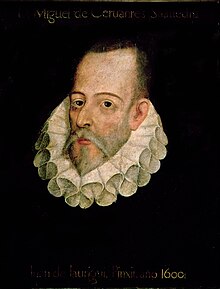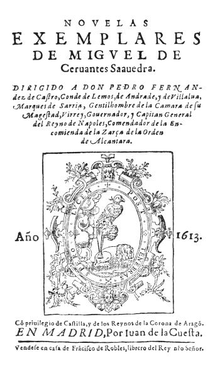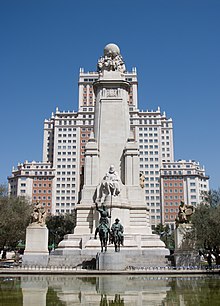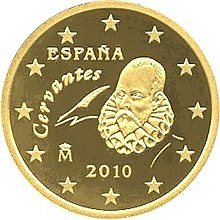Miguel de Cervantes
Miguel de Cervantes Saavedra [ miˈɣel de θeɾˈβantes saːˈβeðɾa ] (* probably September 29, 1547 in Alcalá de Henares , baptized October 9, 1547 in Alcalá de Henares; † April 22 or 23, 1616 in Madrid ) was a Spanish writer . The author of Don Quixote is considered Spain's national poet .
Life
Origin and studies
Miguel de Cervantes Saavedra was born the third of seven children to an impoverished noble family in Alcalá de Henares . His parents were Rodrigo de Cervantes (1509–1585), a traveling surgeon , and Leonor de Cortinas (1520–1593).
The young Cervantes studied theology at the Universities of Salamanca and Madrid .
Escape to Rome and entry into the Spanish Navy
Miguel de Cervantes led a very adventurous life. After studying for a year with the humanist Juan López de Hoyos (1511–1583) in Madrid, where he got to know the writings of Aristotle and those of Erasmus of Rotterdam , he first moved to Rome in 1569 , possibly on the run from the Spanish judiciary. According to a royal decree from 1569, a man named Miguel de Cervantes was to be arrested on charges of injuring a certain Antonio Sigura in a duel. It is possible, but not certain, that it was the later poet Cervantes.
In Rome, probably in 1569, he entered the service of Cardinal Giulio Acquaviva (1546–1574) as a valet . The Italian experiences left clear traces of content and style, especially in his novellas. In the same year he joined a unit of the Spanish Navy stationed in Naples as a poor Hidalgo , to whom hardly any other career paths were open . As a member of the Infantería de Marina , he took part in the Battle of Lepanto in 1571 , in which Juan de Austria , who later certified Cervantes' soldier talents, fought against the Turks. He received three gunshot wounds, two in the chest, one in the left arm or forearm, which permanently paralyzed his left hand and he was nicknamed el manco de Lepanto ( the one-handed from Lepanto ). Alluding to his success with Don Quixote , he later wrote in the story Viaje del Parnaso that he had "lost the ability to move his left hand to the glory of his right hand".
Slave in Algiers
After several years in the Spanish Navy, Cervantes started his voyage home on board the galley Sol in September 1575 . When the ship was approaching the Catalan coast, it was attacked by Algerian corsairs . After a costly battle, the surviving passengers were captured and as slaves to Algiers deported . Only after five years and four unsuccessful attempts to escape could Cervantes be ransomed by the Trinitarian Order in 1580 and returned to Spain on September 19th.
In 1580, after the death of Cardinal King Henry I (Port. Henrique I , Spanish Enrique I ) from the House of Avis , the Spanish King Philip II saw himself as heir to the throne of the Kingdom of Portugal and made his claim militarily in the summer of the same year against the self-proclaimed rival king Antonio von Crato . Between 1580 and 1582, Cervantes took part as a soldier in Spain's military expeditions to Portugal and the Azores .
Husband and writer
In his first play Los Trodos de Argel , which was performed in the 1580s and only published in 1615, he processed his experiences from captivity. He was heavily in debt and eventually tried to establish himself as a writer and make some money like that. His first novel La primera parte de la Galatea appeared in 1585 (the first translation into German was made under the title Der Galatea first part by Felix Schnurrmann in 1588). A year earlier he married Catalina de Salazar y Palacios, 18 years his junior, daughter of a wealthy farmer. This connection remained childless, but he had a daughter, Isabel de Saavedra, from an affair with actress Ana Franca de Rojas. At the end of the 1580s, he separated from his wife.
In 1585 he worked as a tax collector. Since the peasants only had empty barns and he also seized church property, he was excommunicated by an inquisition court . In May 1590 he applied in writing for the vacant governor post of the Central American province of Soconusco ; however, his request was rejected. He then worked, among other things, as a "supply commissioner for the naval administration" and spent 3 months in custody in prison in Seville for alleged misappropriation of state funds in 1597/98 . A second stay in prison in 1602 has not been clearly proven.
There he began to work on his most important work El ingenioso Hidalgo Don Quixote de la Mancha ( The ingenious Junker Don Quixote of La Mancha ), the first part of which appeared in 1605. He published the second part in 1615. Between the two parts, Cervantes' Novelas ejemplares emerged in 1613 , which are translated into German as Exemplary Novellas . In 1616 he completed the novel Los Trabajos de Persiles y Sigismunda (Ed. Madrid 1617). In July 1613, Cervantes joined the secular Franciscan fraternity .
Don Quixote brought the desired success, but Cervantes lost the money he had won.
In the spring of 1616 his health deteriorated noticeably. On April 2nd, when he could no longer leave his home, he took the final vow of the Franciscan Community. He died impoverished on April 22, 1616 in Madrid . The next day he was buried in the convent of the barefoot Trinitarians, which is why this date was long considered the day of his death.
The grave
Cervantes was buried on the grounds of the Discalced Trinitarians' monastery in the city's literary district. His grave was cleared and reburied when the church was rebuilt in the 17th century . A Spanish team of researchers has been systematically searching for the remains since 2014.
In early 2015 - one year before Cervantes' 400th anniversary of his death - it was reported that scientists had found a coffin with the author's initials "MC" in a burial niche . On March 17, the researchers said they had identified the grave. Since Cervantes' bones were buried together with those of other people, an individual assignment of the bones is currently not possible. One might want to carry out a DNA analysis, but today Cervantes no longer has any known descendants.
Known injuries sustained by Cervantes were also helpful in identifying individual bones, such as an injury to his left hand at the age of 24 and at least one gunshot wound to the chest.
plant
Don Quixote
Novelas ejemplares
In 1613 the novelas ejemplares were published. It is a collection of twelve short stories . The collection became a great success and since its first publication has been published in countless editions and has been translated into numerous languages. Cervantes sees himself as the first to use the genre of the novella in Spanish literature. In his foreword he emphasizes that, in contrast to his novellas, the other 'novelas' widespread in Spain are only translations and imitations of foreign originals. But the novellas also refer to events in Cervantes' life. The exemplarity of his novellas is given in two ways. On the one hand, it consists in being exemplary in the moral sense and, on the other hand, being exemplary in relation to literary form can be assumed. Although he wrote his novellas for entertainment, Cervantes emphasized in his foreword the absolute exemplary quality of his novellas. He vowed to chop off his hand if anyone failed to find moral instruction in one of his novels. There was a certain irony in this: In a battle, Cervantes' arm was injured so that he would not have been able to cut off a hand of his own.
Entertainment and moral instruction find their expression in the exemplary novellas at the same time. In the literature, the 12 short stories are often divided into two groups:
- the idealistic short stories
- the realistic or satirical novels
Various influences are assigned to the Novelas ejemplares . For example the theater of the Golden Age (especially in the dialogue), the humanistic dialogue, the knight and shepherd novel, as well as the picaresque novel. However, the influence of his Italian forerunners, especially Giovanni Boccaccio , is controversial, even if he was able to learn from Boccaccio, Bandello and Cinthio in terms of narrative technique and representation of reality .
List of works
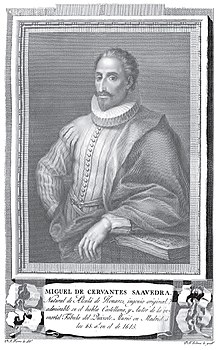
- La primera parte de la Galatea , Alcalá 1585 (German Galathee: Schäferroman , Berlin 1787)
- El ingenioso hidalgo Don Quixote de la Mancha , Roman, Madrid 1605 and 1615 (German Don Quixote von der Mancha , Carl Hanser Verlag 2008)
-
Novelas ejemplares , Novellenzyklus, Madrid 1613 (German moral novellas , Leipzig 1779), therein:
-
La gitanilla ( The Gypsy Girl )
- German excerpt in Adalbert Keil ed .: Die Prophezeiung. Gypsy stories. Row: Goldmanns Yellow TB # 1622. Munich 1965. p. 5f. (An anthology, first Kurt Desch, ibid. 1964)
- as a drama: Pius Alexander Wolff , Preciosa . Romantic drama, music by Carl Maria von Weber , 1821
- El amante liberal ( The noble lover )
- Rinconete y Cortadillo ( Rinconete and Cortadillo , stands in the tradition of the picaresque novel )
- La española inglesa ( The English Spaniard )
- El licenciado Vidriera ( The Licentiate Vidriera )
- La fuerza de la sangre ( The Power of Blood )
- El celoso extremeño ( The Jealous One of Extremadura )
- La ilustra fregona ( The illustrious scrubbing maid )
- Las dos doncellas ( The two rivals )
- La señora Cornelia ( The Miss Cornelia )
- El casamiento engañoso ( The deceptive marriage )
- Coloquio de los perros ( conversation between the dogs )
-
La gitanilla ( The Gypsy Girl )
- Viaje del Parnaso , Epic Poem, Madrid 1614 (German: The Journey to Parnassus , Stuttgart 1968)
-
Ocho comedias y ocho entremeses nuevos, nunca representados , Sechzehn Bühnenwerke, Madrid 1615 (German interludes , Frankfurt am Main 1845; eight plays and eight interludes, all new and never performed, Stuttgart 1970), therein:
- El gallardo español ( The dashing Spaniard ), comedy
- La casa de los zelos y selvas de Ardenia ( The House of Jealousy and the Forests of Ardenia ), comedy
- Los baños de Argel ( The prisons of Algiers )
- El rufián dichoso ( The Lucky Pimp )
- La gran sultana Doña Catalina de Oviedo ( The Grand Sultana Catherine of Oviedo )
- El laberinto de amor ( The love labyrinth )
- La entretenida ( The exuberant woman )
- Pedro de Urdemalas ( Peter Tunichtgut ), comedy of verse in three acts
- El juez de los divorcios ( The divorce judge )
- El rufián viudo, llamado Trampagos ( The Widowed Crook )
- La elección de los alcaldes de Daganzo ( The election of the judges of Daganzo )
- La guarda cuydadosa ( The watchful post )
- El vizcayno fingido ( The Fake Biscay )
- El retablo de las maravillas ( The Wonder Theater )
- La cueva de Salamanca ( The Salamanca Cave ), dramatic interlude
- El viejo celoso ( The Jealous Old Man )
-
Los trabajos de Persiles y Sigismunda , Roman, Madrid 1617
- Persilus and Sigismunda, Ludwigsburg , 1746
- The wanderings of Persiles and Sigismunda . Petra Strien in Romanian. Berlin 2016, Die Andere Bibliothek series , ISBN 978-3-8477-0376-1
- El cerco de Numancia , Tragedy in four acts, Madrid 1784 (German Numantia , first translation 1810 by Friedrich de la Motte Fouqué )
Reception and honors
The Instituto Cervantes cultural institute and the Cervantes Prize , the most important literary prize in the Spanish-speaking world, were named after Cervantes . Several theaters also bear his name. The 10, 20 and 50 cent coins of the Spanish euro coins bear a Cervantes image.
In 1877 a monument was erected to him in Valladolid .
literature
The international Cervantes literature is hardly manageable; a bibliography of individual representations would go beyond the scope of an encyclopedia article. Therefore, only a few German-language introductory biographies and the most important bibliographies are mentioned here:
Biographies
- William Byron: Cervantes. The poet of Don Quixote and his time . Authoris. Translated from d. American. by Hanna Neves. Fischer-Taschenbuch, Frankfurt am Main 1984, ISBN 3-596-25630-5
- Jean Canavaggio: Cervantes. Biography . From the Franz. By Enrico Heinemann and Ursel Schäfer. Artemis, Zurich and Munich 1989, ISBN 3-7608-1003-9
- Anton Dieterich : Miguel de Cervantes . (= Rowohlt's monographs; 324). Rowohlt, Reinbek 1984, ISBN 3-499-50324-7
- Stephen Marlowe : Knights of Chance: Death and Life of Miguel de Cervantes . From the American. by Michael Hofmann. Kindler, Munich 1992. ISBN 3-463-40177-0
- Christoph Strosetzki : Miguel de Cervantes. Epoch - work - effect. CH Beck, 1991 ISBN 3-406-35077-1
- Uwe Neumahr : Miguel de Cervantes. A wild life. Biography . Munich: CH Beck, 2015
Bibliographies
- Leopoldo Ríus: Bibliografía crítica de las obras de Miguel de Cervantes Saavedra . 3 volumes. Murillo, Madrid 1895–1904 (Reprint: Burt Franklin, New York 1970)
- Raymond Leonard Grismer: Cervantes. A Bibliography. Books, essays, articles and other studies on the life of Cervantes, his works, and his imitators . 2 volumes. Wilson, New York 1946 and Burgess-Beckwith, Minneapolis 1963 (reprint: Kraus, New York 1970–1980)
- José Simón Díaz: Bibliografía de la literatura hispánica . Volume 8. Consejo Superior de Investigaciones Científicas, Madrid 1970, pp. 3-442
- A. Sánchez: Bibliografía cervantina , in: Anales Cervantinos, Vol. 21, 1983, pp. 225-281 and Vol. 22, 1984, pp. 239-293
- Krzysztof Sliwa: Documentos Cervantinos. Nueva recopilación. Lista e índices . Lang, New York et al. 2000, ISBN 0-8204-4465-0 (about the estate)
Fiction
- Bruno Frank : Cervantes . Querido, Amsterdam 1934 (historical novel, most recently by Ullstein, Frankfurt am Main 1992, ISBN 3-548-22688-4 )
Movie
In 1967 Vincent Sherman directed Cervantes - The King's Adventurer, a biopic based on the novel Cervantes by the German writer Bruno Frank . Horst Buchholz played the title role in the Spanish-Italian-French co-production, which was conceived as a period film .
Web links
- Literature by and about Miguel de Cervantes in the catalog of the German National Library
- Works by and about Miguel de Cervantes in the German Digital Library
- Literature by and about Cervantes Saavedra in the catalog of the Ibero-American Institute in Berlin
- Literature by and about Miguel de Cervantes in the catalog of the library of the Instituto Cervantes in Germany
- Works by Miguel de Cervantes in the Gutenberg-DE project
- Works by Miguel de Cervantes in Project Gutenberg ( currently usually not available for users from Germany )
- Publications by and about Miguel de Cervantes in VD 17 .
- Works by Miguel de Cervantes at Zeno.org .
- Miguel de Cervantes - "Don Quixote de la Mancha" from the series classics of world literature by BR-alpha
- Ulrich Noethen reads Bruno Frank's Cervantes biography, 29 half-hour episodes, MDR Kultur
Individual evidence
- ^ Compare Brockhaus Enzyklopädie , fourth volume, BRO-COS, Mannheim: FA Brockhaus, 1987, p. 391, and see Encyclopaedia Britannica , Volume 3, Ceara-Deluc, Fifteenth edition, Chicago: Encyclopaedia Britannica, Inc., 2007. p 41.
-
↑ a b Shakespeare and Cervantes: Two geniuses, one day of death . In: Deutsche Welle , April 23, 2016, accessed on September 10, 2020:
- Miguel de Cervantes was buried on April 23 and died the evening or the night before; in Spain April 22 is the anniversary of his death.
- ↑ Volker Klimpel : Famous amputees. In: Würzburger medical history reports 23, 2004, pp. 313–327; here: p. 314.
- ↑ G. Steiner, H. Greiner-Mai (ed.): Fremdsprachige writers. Leipzig 1971, p. 137
- ^ Cervantes: Don Quijote Vol. I, Dieterich'sche Verlagsbuchhandlung, Leipzig 1953. Comments by the publisher Werner Bahner p. 667f.
- ↑ Fitzmaurice-Kelly, James: Miguel de Cervantes Saavedra; Oxford, Clarendon press 1913, p. 179 online at archive.org
- ↑ Fitzmaurice-Kelly, James: Miguel de Cervantes Saavedra; Oxford, Clarendon press 1913, pp. 201 f.
- ^ Cervantes: Don Quijote Vol. I, Dieterich'sche Verlagsbuchhandlung, Leipzig 1953. Timeline pp. XI - XIII.
- ↑ stuttgarter-zeitung.de , April 28, 2014, Martin Dahms: Madrid is looking for its most famous dead
- ↑ badische-zeitung.de , January 27, 2015: The bones of Cervantes?
- ↑ Camila Ruz: Spain finds Don Quixote writer Cervantes' tomb in Madrid. BBC News, March 17, 2015, accessed March 17, 2015 .
- ↑ Neue Zürcher Zeitung , March 7, 2015, Cervantes grave found - maybe
- ↑ badische-zeitung.de , March 19, 2015, Martin Dahms : "It is possible to consider ..."
- ^ [1] Digitized version, accessed on August 31, 2020
| personal data | |
|---|---|
| SURNAME | Cervantes, Miguel de |
| ALTERNATIVE NAMES | Cervantes y Saavedra, Miguel de (full name) |
| BRIEF DESCRIPTION | Spanish writer |
| DATE OF BIRTH | September 1547 |
| PLACE OF BIRTH | Alcalá de Henares , Spain |
| DATE OF DEATH | April 22, 1616 |
| PLACE OF DEATH | Madrid , Spain |
